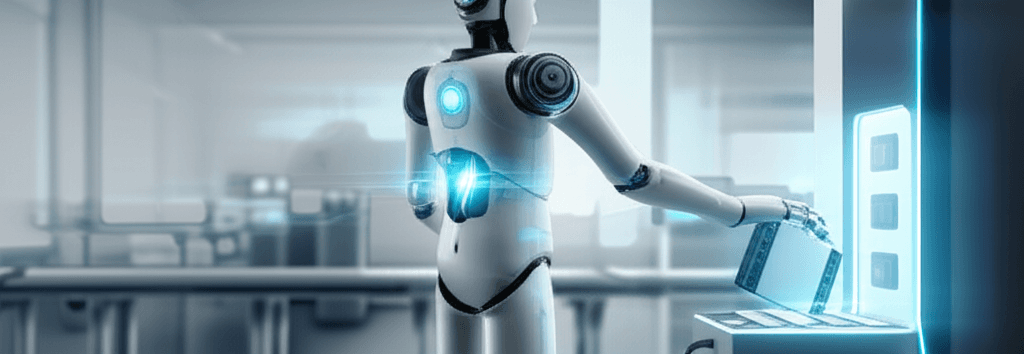Humanoid Robot Walker S2 Autonomously Changes Batteries, Unlocking 24/7 Factory Work
Revolutionizing factories: This humanoid robot autonomously swaps its own batteries, enabling continuous 24/7 operation and unprecedented productivity.
July 23, 2025

A new frontier in industrial automation is unfolding with the introduction of a humanoid robot capable of autonomously managing its own power supply. The Walker S2, developed by Shenzhen-based UBTech Robotics, has demonstrated the ability to change its own battery, a significant leap toward achieving continuous, 24/7 operation without the need for human intervention.[1][2] This development addresses one of the most significant limitations in mobile robotics, paving the way for more efficient and independent automated workforces in factories and warehouses.[3] The robot's ability to self-sustain its operational uptime by swapping power sources signals a pivotal moment for the AI and robotics industry, highlighting a shift from task-specific automation to more versatile and autonomous systems.
The core innovation of the Walker S2 lies in its hot-swappable dual-battery system and its autonomous ability to perform the battery exchange.[4][5] When the robot's internal sensors detect low power levels, it can autonomously navigate to a specially designed charging station.[1] In a process that takes less than three minutes, the robot uses its own arms to remove the depleted battery pack from its back, place it in a charging bay, retrieve a fully charged unit, and insert it into its own power port.[2][5] This entire sequence is completed without shutting down, thanks to a dual-battery design that allows it to switch to a backup power source during the swap, ensuring uninterrupted operation.[6][7] This functionality not only minimizes downtime but also reduces the need for human maintenance, thereby enhancing overall production efficiency.[5] The Walker S2 stands approximately 5 feet 3 inches tall and weighs around 95 pounds, and can operate for about two hours of walking or four hours of standing before needing a battery change.[8][9]
The implications of a self-sufficient humanoid robot for industrial automation are profound. The ability to operate continuously, with downtime limited to the few minutes it takes to swap a battery, presents a significant advantage for manufacturing and logistics sectors that rely on round-the-clock productivity.[4][3] UBTech has already tested its Walker series robots on the production lines of major Chinese electric vehicle manufacturers like BYD, Nio, and Zeekr, where they perform tasks such as handling and quality inspection.[2][6] The introduction of the Walker S2 and its battery-swapping capability is poised to accelerate the integration of humanoid robots into these and other industrial settings.[5] By taking over repetitive and labor-intensive tasks, these robots can reduce the physical strain on human workers and allow them to focus on more complex responsibilities.[10] The prospect of fully automated "dark factories," where robots operate continuously without the need for lighting or human supervision, moves closer to reality with this technological advancement.[11]
The development of the Walker S2 is indicative of a broader trend in the robotics industry toward creating more intelligent and autonomous systems. The integration of advanced AI and machine learning is crucial for enabling robots to perform complex tasks, navigate dynamic environments, and interact safely and effectively with their surroundings.[12][13] For the Walker S2, AI algorithms are not only responsible for its bipedal locomotion and task execution but also for its ability to monitor its own energy levels and decide whether to swap or recharge its battery based on the urgency of its current tasks.[6][7] This level of dynamic energy management is a key step towards creating truly autonomous machines.[6] Furthermore, UBTech's partnership with Huawei to enhance the "embodied intelligence" of its robots suggests a future where these machines can collaborate and share information through a cloud-based network, further increasing their efficiency and capabilities.[1][14]
In conclusion, the Walker S2's ability to autonomously change its own batteries marks a significant milestone in the evolution of humanoid robots. This capability directly addresses the critical challenge of limited operational uptime, opening the door for continuous, uninterrupted work cycles in industrial environments.[1][3] As the technology matures and becomes more widespread, it has the potential to revolutionize manufacturing and logistics by creating a more efficient, resilient, and autonomous workforce. While challenges related to cost, large-scale deployment, and the development of even more sophisticated AI remain, the Walker S2 represents a tangible step towards a future where humanoid robots are a standard and integral part of the industrial landscape, working alongside humans to drive productivity and innovation.[5][15]
Sources
[1]
[2]
[4]
[5]
[9]
[10]
[11]
[12]
[14]
[15]